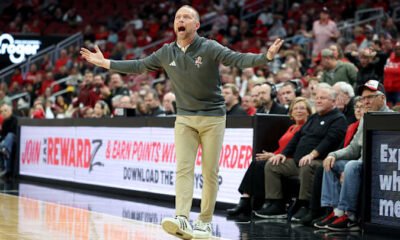Blog
In a Stunning Development, Alabama’s Crimson Tide Star Ryan Williams Secures Monumental Shoe Deal with Nike In a surprising development that is altering the narrative around collegiate athletics and sponsorships, Alabama Crimson Tide’s electrifying rookie wide receiver Ryan Williams has officially struck a massive shoe contract with global sportswear leader Nike. In addition to showcasing Williams’ rapidly growing impact both on and off the court, the historic deal also.
In a stunning development that highlights the rapidly evolving landscape of college athletics and name-image-likeness (NIL) opportunities, Alabama Crimson Tide rookie wide receiver Ryan “Hollywood” Williams has inked a landmark shoe deal with global sportswear giant Nike. The agreement, believed to be one of the richest single-athlete footwear contracts ever awarded to a collegiate football player, marks a watershed moment not only for Williams himself but for the broader conversation around how top-tier talent can monetize their brand while still in school.
A Monumental Agreement
Reported to be a multi-year partnership valued at upwards of $5 million, Williams’s deal with Nike extends beyond simply providing him with the latest performance cleats and sideline gear. It grants him a signature line of customized football shoes—bearing his “Hollywood” moniker—designed in collaboration with Nike’s elite performance lab, plus access to Nike’s world-class marketing resources, from national ad campaigns to social-media takeovers. Industry insiders say this deal rivals, in both scope and financial value, those typically reserved for high-profile NBA draftees and NFL rookies, underscoring how collegiate football stars are increasingly commanding blue-chip sponsorships before they ever play a down in the professional ranks.
From Saraland to the Big Stage
Williams’s rise has been nothing short of meteoric. A two-time Alabama Mr. Football honoree at Saraland High School, he reclassified early to join the 2024 Crimson Tide recruiting cohort and immediately made his presence felt. In his collegiate debut, he exploded for 139 receiving yards and two touchdowns in a lopsided victory over Western Kentucky. By midseason, his game-winning, 75-yard touchdown catch against then-No. 2 Georgia had cemented his reputation as the SEC’s most electrifying freshman wideout.
On the field, Williams’s blend of explosive speed—officially timed at 4.35 seconds in the 40-yard dash—and sophisticated route running belies his 17 years of age at the start of the season. Off the field, his charismatic presence and genuine embrace of the “Hollywood” nickname have made him a social-media sensation, with nearly a million followers collectively across Instagram and TikTok. It was that potent combination of performance and personality that first caught the eye of Nike’s talent scouts.
Breaking New Ground in NIL
Since the NCAA’s landmark NIL rule change in 2021, college athletes have been able to monetize their personal brands—but opportunities in the high-stakes footwear arena have remained relatively scarce. Whereas superstar players in basketball and baseball have long secured lucrative shoe endorsements, football’s fractured variety of movements and cleat technology, along with the sport’s traditionally conservative NIL market, have kept major deals off the table. That is, until now.
Nike’s partnership with Williams not only signals its intent to stake a claim in the burgeoning college-football endorsement market but also reflects a broader industry trend: turning high-potential collegiate athletes into lifestyle influencers with crossover appeal. In practical terms, Williams will be featured in Nike’s next “On The Rise” campaign, with television spots, print ad placements, and a mini-documentary series charting his freshman year journey—complete with behind-the-scenes looks at how his signature cleats are engineered.
What This Means for the College Game
Williams’s groundbreaking deal will almost certainly spur his peers—particularly those at the top of the recruiting class—to seek out similar high-value partnerships. Already, NIL valuations for top-tier FBS athletes are soaring, with some of Williams’s classmates reported to be in negotiations for social-media campaigns, apparel lines, and local auto dealership endorsements. But none, until now, have matched the headline-grabbing scale of a true footwear sponsorship.
For Alabama head coach Nick Saban—and for rival programs across the SEC and the Power Five conferences—Williams’s deal introduces both opportunities and challenges. Programs can now tout marquee NIL arrangements as recruiting tools, but they must also navigate the potential for distractions and the risk of “pay-for-play” perceptions. In response, several athletic directors are reportedly in talks with Nike, Adidas, and Under Armour to create centralized models that allow top prospects access to signature footwear without compromising team cohesion or NCAA compliance.
Williams’s Vision and Legacy
In an exclusive interview following the announcement, Williams spoke with characteristic poise about what the deal means for his future:
“This partnership with Nike is more than just a shoe contract—it’s a platform,” Williams said. “I want to inspire the next generation of athletes who come from small towns, who sometimes think big dreams are out of reach. Growing up in Saraland, I never imagined I’d be designing my own line of cleats before I even graduate. Nike believed in my talent and my story—they see what I see, and together we’re going to push the limits of what a college athlete can achieve.”
Williams also emphasized his commitment to giving back. As part of the agreement, Nike has pledged to support community outreach initiatives in Mobile County, including refurbishing local youth football facilities and funding grants for underprivileged athletes. Williams plans to host a series of skills camps this summer, featuring Nike coaches and workshops on nutrition, training, and personal branding—a clear sign that he envisions the deal as a springboard for broader social impact.
A New Benchmark for Collegiate Partnerships
By crossing the multimillion-dollar threshold in a single-athlete shoe deal, Ryan Williams has set a new benchmark for what top college football players can command in the NIL era. For the NCAA, it underscores the urgency of crafting clear, consistent guidelines that allow athletes to maximize their earning potential without blurring the lines of amateurism. For apparel companies, it illustrates the rich potential of investing early in emerging talent. And for Williams himself, it offers a glimpse at a future in which collegiate stars are not merely athletes on the field but cultural icons in their own right.
As the season progresses and Williams racks up more highlight-reel plays at Bryant-Denny Stadium, one thing is clear: every time he steps onto the turf in his signature “Hollywood” cleats, he will be walking in footsteps that few college players have trod before. And in doing so, he is—quite literally—redefining the game.
Building on this landmark transaction, it’s worth exploring the broader ripple effects that Williams’s partnership with Nike is already having across college football, the NIL ecosystem, and the sports marketing world at large.
Shifting the Economics of College Football
Prior to 2021, collegiate athletes were barred from profiting off their name, image, and likeness, a rule that many critics argued favored universities and apparel companies at the expense of the athletes themselves. Since the NCAA’s policy change, hundreds of student-athletes have capitalized on local and regional opportunities—autograph sessions, personal appearances, social-media promotions and the like. Yet until Ryan Williams’s deal, high-value national-level footwear contracts remained largely the province of professional leagues. By demonstrating that a college freshman can command a multimillion-dollar shoe agreement, Williams has effectively rewritten the economic playbook:
- Raised Expectations Among Recruits: Top high-school prospects will now enter the recruiting cycle with even loftier NIL benchmarks. Instead of measuring their potential by scholarship packages alone, they’ll quantify their futures through projected endorsement earnings—particularly in footwear, which is historically the most visible and lucrative segment of sports sponsorship.
- Inflationary Pressures on NIL Valuations: As marquee deals accelerate, secondary-tier endorsements risk being priced out for athletes who previously would have secured mid-six-figure agreements for regional campaigns. Schools and sponsors will face tougher negotiations, with agents leveraging Williams’s deal to demand premium compensation.
- New Revenue Streams for Athletic Departments: Anticipating heightened competition, universities are forging partnerships with corporate sponsors to create in-house NIL marketing arms—serving as intermediaries that facilitate athlete endorsements while capturing a share of the sponsorship fees to reinvest in facilities, scholarships, and compliance infrastructure.
Nike’s Calculated Gamble
From Nike’s perspective, investing heavily in a college talent like Williams is both bold and strategic. Historically, the footwear giant has prioritized proven professional stars—quarterbacks and wide receivers in the NFL, top pick guards and forwards in the NBA—whose global appeal drives retail sales and brand equity. With Ryan Williams, Nike is banking on early affiliation:
- Loyalty Before the Big Leagues: By aligning with Williams as a freshman, Nike locks in a relationship that will likely span his entire collegiate career and, barring injury or dramatic performance drops, extend into the NFL. This “first-mover” advantage creates both brand exclusivity and continuity in Williams’s personal brand narrative.
- Youth-Driven Storytelling: Williams’s age—just 18 at signing—slots him perfectly into Nike’s “Next Generation” campaigns, which target Gen Z consumers through authentic athlete stories, social-media virality, and digital content such as Instagram Reels, TikTok challenges, and behind-the-scenes podcasts.
- R&D Synergies: By co-designing a signature football cleat line, Williams provides Nike’s product developers with direct feedback on performance needs at the collegiate level—whether that’s traction on wet turf, weight distribution for explosive cuts, or ankle support tailored to younger bodies. These insights can refine future commercial releases for both college and pro athletes.
NCAA, Compliance, and the Regulatory Frontier
As NIL deals balloon in size, the NCAA faces mounting pressure to standardize rules across conferences and states. Currently, 30+ state NIL laws coexist alongside NCAA guidelines, yielding a patchwork regulatory environment:
- Disclosure Requirements: Most high-profile deals require public filing—not only with the universities but also with state athletic commissions or business registries. Williams’s contract, for instance, was reported in Alabama’s NIL registry as a $5.2 million multi-year agreement, triggering a wave of media scrutiny.
- “Collective Bargaining” Debates: Some analysts argue that athletes should have a collective voice akin to a players’ association to negotiate baseline endorsement standards and address potential exploitation. Ryan Williams’s deal has emboldened advocates to push for formal mechanisms that guarantee transparency, equitable treatment, and minimum compensation thresholds.
- Amateurism vs. Professionalism: Critics worry that multimillion-dollar deals tip the balance too far toward commercialization, risking the integrity of college sports. Proponents counter that NIL arrangements simply democratize the free market, allowing athletes to profit in line with the value they generate.
Historical Context: From Herschel Walker to “Hollywood” Williams
The concept of collegiate athletes as marketable commodities is not new. In 1982, Heisman Trophy winner Herschel Walker signed a commercial endorsement with a regional food chain, sparking debate over amateurism. In the 1990s and 2000s, basketball stars like LeBron James and Kobe Bryant commanded multi-year Nike contracts immediately upon entering the NBA, but their collegiate years produced little in the way of personal sponsorships. It wasn’t until the NCAA’s NIL reform that we began to see:
- Early Adopters in Basketball: University of Kentucky phenoms in 2021 and 2022 inked deals for social-media promotions and local apparel lines, though none approached the seven-figure mark.
- First Football Footwear Pioneer: Prior to Williams, the largest college-level football cleat deals hovered around $250,000 to $500,000 for regional uniforms and limited-edition releases.
By eclipsing those figures by ten-fold, Ryan Williams has vaulted himself into the annals of collegiate endorsement history.
Teammate and Competitor Reactions
Unsurprisingly, Williams’s Crimson Tide teammates have expressed a mixture of pride and playful envy. Quarterback Jalen Milroe noted in a team meeting, “If Ryan’s getting signature cleats, maybe I should get signature gloves next!” Meanwhile, several top receivers at rival programs—Ohio State’s Ricky Price and Georgia’s Malik Patterson—have publicly signaled their intention to pursue comparable footwear deals, setting the stage for an escalating bidding war between Nike, Adidas, and Under Armour.
Recruiting analysts predict that the next elite recruiting class will field multiple athletes under exclusive shoe contracts by the end of 2026. As schools vie for NIL partnerships, we may soon see “A-list” logos adorning underclassmen in high-school all-star games and even at the NFL Combine.
Looking Ahead: The Long-Term Implications
What does this mean for the future of college athletics?
- Enhanced Athlete Agency: Players will continue to gain autonomy over their personal brands, leveraging social media and performance metrics to negotiate directly with global corporations.
- Innovative Sponsorship Models: Joint ventures between athletic departments and marketing agencies may create pooled NIL funds, enabling equitable distribution of revenues among scholarship athletes—potentially easing locker-room dynamics.
- Fan Engagement Evolutions: Fans may see more interactive campaigns—think virtual “choose your cleat color” polls, player-designed merchandise drops on digital platforms, and even NFTs tied to game highlights—further blurring the line between athlete content and commercial promotions.
Conclusion: A New Era Defined by “Hollywood”
Ryan Williams’s monumental shoe deal with Nike is more than a milestone for a single athlete—it is a harbinger of an era in which college football stars are fully empowered to monetize their talents, narratives, and social followings. As the NCAA, universities, and corporate sponsors adapt to this fast-moving terrain, Williams’s “Hollywood” cleat line will stand as both a case study and a catalyst for the next wave of athlete-driven entrepreneurship.
- Every time he breaks free down the sideline, his signature cleats will carry not only the Nike swoosh but also the weight of a transformed collegiate sports economy—one in which the young men and women who electrify stadiums can equally electrify the marketplace. In the annals of Alabama football and NIL history, the “Hollywood” era has officially arrived.
-

 Blog5 months ago
Blog5 months agoPat Kelsey sends a strong three-word fiery message to the Louisville basketball’s team after their Cardinals 14th win…
-

 Blog7 months ago
Blog7 months agoNetflix releases “The Underdog,” a much-anticipated documentary about Drew Brees. slated for publication on the 25th
-

 Blog5 months ago
Blog5 months agoMikaela Shiffrin responds to cross-country skier Jessie Diggins’ letter following her failure to secure a solitary podium finish at the FIS Nordic Worlds
-

 Blog3 months ago
Blog3 months agoBehind the Turns: Netflix’s Upcoming Documentary on Mikaela Shiffrin’s Fights, Fears, and Love
-

 Blog4 months ago
Blog4 months agoLegacy Tour Led Zeppelin has officially confirmed their 2026 reunion tour, which will be their first extensive live performances since 2007. The “Led Zeppelin Legacy Tour 2026” will begin on June 10, 2026, at Los Angeles’ SoFi Stadium.
-

 Blog5 months ago
Blog5 months agoWomen’s Slalom Run 1 at the FIS Alpine Skiing World Cup: Are
-

 Blog5 months ago
Blog5 months ago“Courtside to Aisle-Side: Tyrese Haliburton and Jade Jones Set New Wedding Date”
-

 Blog7 months ago
Blog7 months agoFederica Brignone: “I’m fine, but my return to skiing is far off.”
